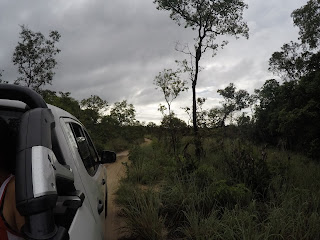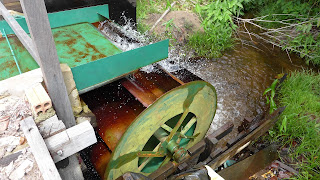Day Twelve: Sunday, January 22, 2017
Well, the rains that threatened our piracaia never came, but
the rains DID come in the night. Oh, did
they! Our whole top floor is covered
with a tarp-like roof but it is not enough to protect people sleeping up there
from pouring rain. They were
surprisingly orderly about getting themselves down the stairs and finding
places to land on the main floor and in the jungle room. They quietly squeezed between existing
hammocks and a few of them crashed onto the bunks downstairs. Only one person landed on the floor. Because it was Joe, we are pretty sure he
will complain to the manager. He likes
to do that. Our #1 snorer was in the
jungle room and somehow made the benevolent decision to stop snoring for one
night. Once things settled down, the
rain was pretty welcome white noise that helped us sleep until breakfast.
It was still raining when we ate breakfast but we were
confident that it would stop before we started our excursion for the day. The sky stayed cloudy and the wind still
blew, but we were able to head off to CEFA, which is a reforestation project
that started just before our trip last year.
We visited the budding enterprise when it was brand new and now we had a
chance to see if they have realized their aspirations.
When we visited last year, They were just building a new oca
for guests and visitors and they already had a nice bathroom and kitchen
area. Now they have expanded even
further and are working on a number of new projects, including a small dam to
provide power to their own complex and some neighboring homes. The
hydroelectric project is not quite functional, but is impressive already, as
the waterwheel has been installed and it is clear that the plan is going to
work. They can also grow some aquatic
plants in the dammed lake and they intend to start a fish farm there as
well.
They have also tested a new mode of septic treatment that is
called something like “vapo-transpiration,” which involves growing plants over
the septic tank. They have some huge
banana trees over one of their septic tanks, growing some of the largest
bananas we’ve seen in this area. Because
they have managed to make this situation work here, they are likely to spread
this new strategy across the region to improve waste treatment methods for many communities.
The whole enterprise at CEFA is about experimentation to try
to improve the preservation and use of the “active forest.” And all of these experiments are over and
above the 50,000+ tree starts that they are propagating for replanting in the
communities around their compound. They
are seeking interns to help them with their work and we will have to see if a
few SMC students might want to be among those numbers.
We had lunch at the CEFA compound, then hurried back to the
boat in time to find Gui, who had stayed behind, getting started on the movie
Zootopia (in Portuguese with English subtitles) on the large screen TV in our
strange party boat. So suddenly, after
almost two weeks being cut off from most media, we all gathered around a screen
and watched a movie with our young friend.
Louro made popcorn and pão de queijo (cheese bread, a fabulous Brazilian
staple). We needed to motor for a couple
of hours to our next destination, so this combination was just the perfect
recipe for a happy voyage.
We were heading to the second place that every one of our
Brazil trips has stopped during the boat trip: Urrucurreá. The people of this particular community are
at the forefront of the local artisan movement, as they perfected the art of
basket-weaving many years ago and now have become world famous for their
work. Along with Ponta Grande, this
community has become a necessary stop for all of our groups.
We already knew that their beach is a perfect spot for our
postponed piracaia so we decided to head on over there early to get things
started. While Louro and our crew dug a
pit in the sand to start a fire, we all bathed in the river and just floated,
letting the clouds cross the sky above us as we just took it all in.
We started our own separate bonfire and gathered around
it. Shawny, Jesse and Gui went out in a
motorboat to try to find signal to post the blog text. Jesse and Gui got enough signal to talk to
home, but there wasn’t enough to post or make international calls.
When they got back, the fish (tambaqui – pronounced
tom-bah-KEE) was ready and Louro served up HUGE portions of it to each of
us. We had also roasted potatoes,
which were a welcome distraction from our daily doses of manioc. There was a ton of other food as usual, so we
ate like kings (except for Natalie and Claudia, who still haven’t gotten their
heads around enjoying fish – they have been very brave in trying multiple
versions, not all of which disgusted them, but they haven’t converted to
fish-eaters).
There was a quick challenge over eating the huge eyeball
from one of the fish heads, which turned into a triple challenge involving
Claudia, Jules and Joe. They all ate the
fish eyes, some with more gagging than others.
Gui, on the other hand, took up the challenge and really liked it.
We started playing word games around the fire, including a
somewhat confusing one called “Contact.”
We were all together and playing round after round, so we just let it
roll instead of stopping things for our world premier (that’s what we call our
video screenings), reflection session and purple bike ceremony. We’ll catch up on all of that later.
We finally realized how late it was getting (after 11!! For college students!! And that’s late!!) so
we headed in and started stretching our hammocks. We’ve all gotten good at tying the knots
necessary to sling our hammocks just right and we’ve gotten very intuitive
about staggering them so that some of us hang high and some hang low, meaning
everyone has space (and air!) to themselves.
We are a remarkably unified group. We don’t have factions or cliques; we don’t
break off into separate groups when the opportunity arises. We just all stay together because that’s what
we want to do. It’s surprising. And it’s nice. Lucky us.
At
CEFA, the dirties explored the nursery for several different seedlings. The
seedlings are sold to community members so they can harvest products from the
plant.
Silvanei shows the dirties how CEFA uses the sewage system to fertilize banana trees.
This sewage treatment method is known as vapo-transpiration.
CEFA is a research facility for neighboring communities in the Amazon. They research
ways to be more sustainable and more effective in areas such as energy, beekeeping/honey,
and farming in connection with reforestation.
CEFA focuses on innovation and creativity. Currently they are building a dome that
will be used as sleeping quarters. They say part of the fun will be discovering
how to incorporate details such as a roof, doors, and windows for a structure
they have never built before on their facility.
Who Wore it Better? Shawny
and Colleen noticed that they had matching outfits while waiting for our exciting
tour around CEFA. Maybe the blue shirts were good luck as they later saw a
beautiful blue butterfly.
We’ll miss Joao Felipe II, thank you for being our home for the
past 3 days #imonaboat
I’m a piranha, I’m from the Amazon #findingNemo
Taking a tour around CEFA
Look at these little saplings from CEFA (Center
for Environmental Action) #sustainable(:
One of the experiments CEFA is working on is a new style of
Oca, which features a lightweight wood design and larger structure. They are
still unsure of how to finish this structure, but are making decisions as they
go.
Upon our arrival back to the boat, we were
surprised to find that Gui and the crew had caught a piranha. This is not
something you would want your big toe to encounter due to their sharp teeth.
On a rough and bumpy ride to CEFA we couldn’t help but
notice the amazing scenery. The road only took about two days to create because
of the numerous participants and large equipment that helped transform this
walking path into a drivable road.
A structure CEFA built this past year is a small dam that will
produce energy for up to 16 families throughout the community. Their hope is
that this experiment will be the first of many eco-friendly and sustainable projects
for small Amazonian communities.
CEFA, an organization that helps in the reforestation of the
Amazon, has dedicated part of their program to planting various native plants and
trees to distribute to local communities.














Wow! This adventure keeps getting better and we are living vicariously through these videos, pictures and posts. Your adventure is making memories that will last a lifetime! We love that you are all so cohesive and working/living together so well. This is how the world should always be.
ReplyDeleteWith love (and some envy...)